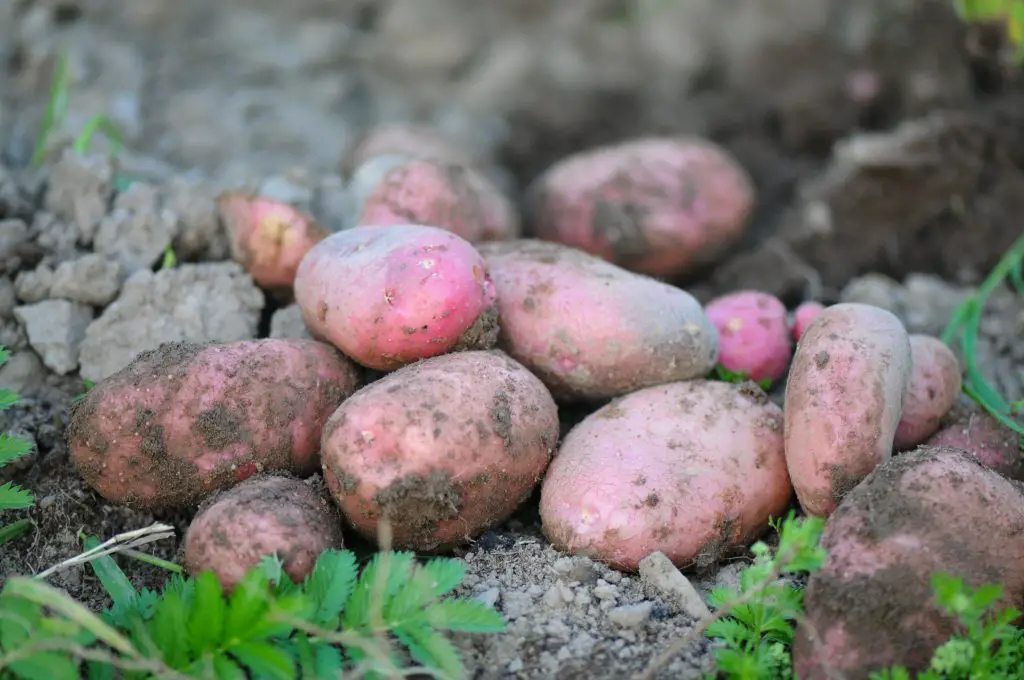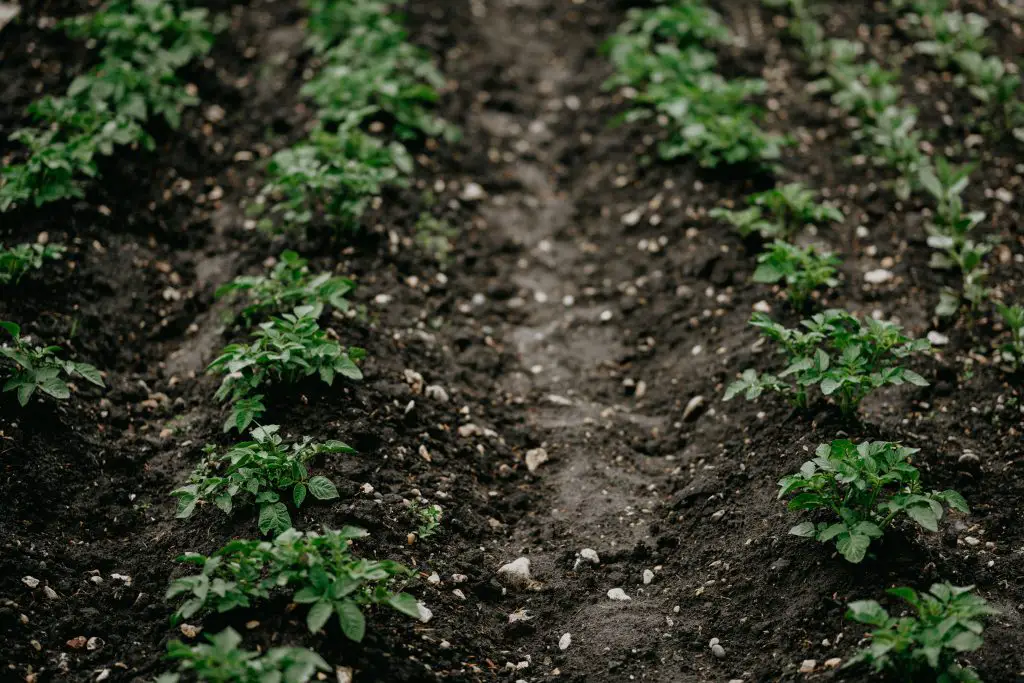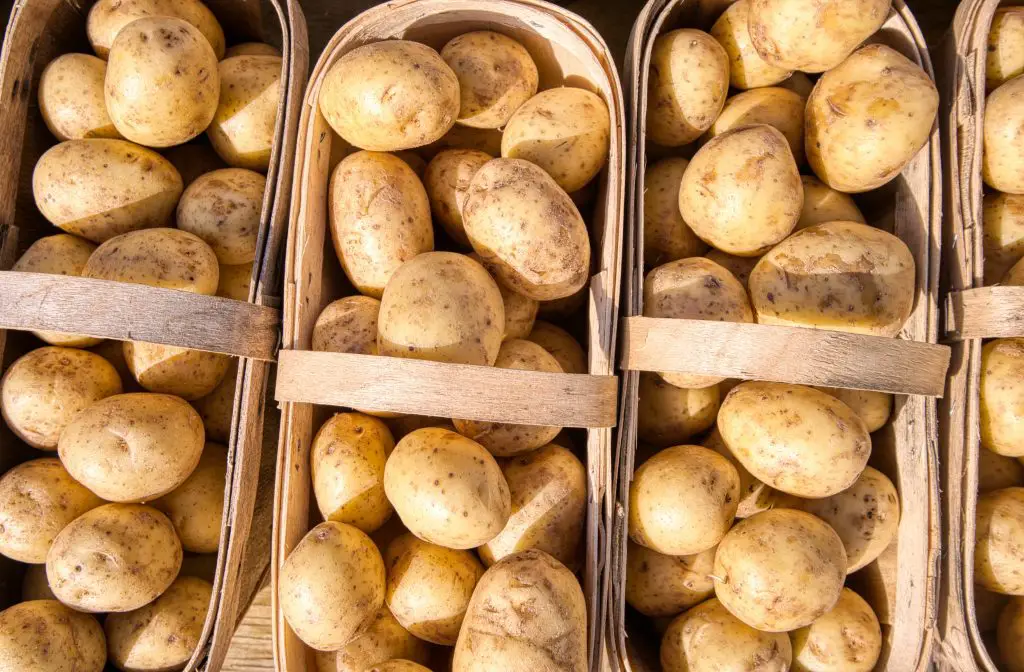Does Earthing Up Potatoes Improve Yield? Potatoes are one of the most worthwhile vegetables to grow in the backyard. They produce a reliable yield and require very little maintenance. However, the one job that is frequently required according to the experts is earthing-up or hilling. But does this process really help the potatoes to produce a larger yield?
Earthing up potatoes (or hilling) is a process in the garden that will make a substantial difference to the size of the crop. Studies indicate that the crop that is anywhere between 30% to 70% larger when soil is earthed up because both the size and number of the potatoes produced is increased.
Additionally, the process of earthing-up also protects the tubers from exposure to sunlight which will cause the tubers to turn green and become poisonous.
An 2010 academic study in Iran looked at the effect of earthing up potatoes on 4 different varieties. They found that in all varieties tested the yield increased dramatically. A summary of the results of this study is provided in the table below, all results presented are in grams.
| Variety | Av. Tuber Size (Control) | Av. Tuber Size (Earthed-Up) | Tubers Per Plant (Control) | Tubers Per Plant (Earthed-up) | Total Yield (Control) | Total Yield (Earthed-Up) |
| Arinda | 177.6 | 196.5 | 5.8 | 7.7 | 1030.1 | 1513.1 |
| Sante | 231.5 | 281.5 | 7.1 | 8.8 | 1643.7 | 2477.2 |
| Marfona | 213.6 | 233 | 6.5 | 7.7 | 1388.4 | 1794.1 |
| Ramous | 240.0 | 301.5 | 7.9 | 11.0 | 1896.0 | 3316.5 |

Why Does Earthing Up Improve The Harvest?
Earthing up potatoes is an effective method of increasing the yield because the mounding of soil around the above-ground stems encourages these sections of the stems to start producing tubers rather than leaves which increases the number of tubers produced.
The effectiveness of this technique increases when the earthing up is done earlier in the season as this increases the length of time that the tubers spend underground. This in turn increases the length of time that tubers have to grow and develop.
When Should Potatoes Be Earthed Up?
Once seeds potatoes have been planted you will see the foliage emerge a few weeks later. Allow the foliage to get to a height of 4 to 6 inches in height before pushing the soil around the potatoes. The soil should remain loosely packed around the plant to enable the plant to continue to penetrate the soil. When covering the plants it is important to ensure that the tops of the plant remain uncovered as this will allow the plant to continue to do photosynthesis.
The plant will continue to grow and produce shoots that get progressively taller. When this occurs it will be necessary to complete the process again to further encourage the formation of new tubers. Typically this will be required to be done a few times early on in the growing season, usually during May and the first week of June, for those living in the northern hemisphere.
However, it should be noted that continuing to earthing-up in things like potatoes towers, which can be 3 to 4 ft tall, does not result in ever-increasing potato yield. According to gardenmyths.com early and mid-season potatoes produce new potatoes at ground level which means that potatoes tend not to be formed all the way up the tower. Gardenmyths.com has indicated that this is consistent with the observation of many people.

Do You Have To Use Soil To Earth-Up Potatoes?
It is most common to use soil to earth-up potatoes however gardeners have been known to use a range of materials which include straw, dried leaves, and grass cuttings. Generally, I recommend using soil rather than anything else as it provides an increased volume of growing space that is ideally suited to the production of additional tubers as the conditions are moist and contain the nutrients required for additional growth.
However, the use of other materials in the absence of soil does provide benefit, ie any type of earthing-up is preferable to none at all.
What Happens If You Don’t Earth Up Potatoes?
Earthing-up is not essential to get a reasonable harvest of potatoes however, it does generally improve the quality of the potatoes that are produced. It is common when growing potatoes to see potatoes protruding from the soil as the season progresses. This occurs because the tubers swell in the ground and push up through the soil later in the season.
If this occurs sections of the potatoes will begin to turn green and become poisonous. This can result in the loss of yield as some potatoes may need to be thrown away. However, it is often possible in these circumstances to cut off the exposed part of the potatoes and eat the remainder of the tuber.
How Do Tell When Potatoes Are Ready To Harvest?
The length of time that you need to wait before harvesting potatoes is dependent upon the type of potatoes. Potatoes are typical classed as first early potatoes, second early potatoes, and maincrop potatoes.
As the name suggests first early potatoes are the earliest to potato crop to arrive and will typically take 10 to 12 weeks to mature. Second early potatoes generally take a little longer, around 12 to 16 weeks. These varieties are often grown in pots or grow bags in places like the UK and will produce smaller tubers and a smaller overall harvest. To read more about the best varieties click here.
Maincrop potatoes are the major crop for the year and are generally much larger in size than either first or second early potatoes. They typically take between 16 to 22 weeks to mature and are generally harvested in the latter parts of the growing season.

Indications That The Potatoes Are Ready To Harvest
While the type of potatoes you are growing will give some indication of when the potatoes are ready to harvest, the plant itself will provide some indications. The strongest indication that the tubers are approaching the point where the tubers will be a reasonable size is when the plant begins to produce flowers.
It is generally recommended that harvests commence a few weeks after the plants have first flowered. When harvesting potatoes it is best to only harvest what you need as leaving the plants in the ground will allow the potato tubers to continue to increase in size.
The size of harvest you can typically expect varies between 0.5 kg to 3 kg (1 to 6 lbs) per plant however, this is dependent upon the particular variety and also how you have grown the potatoes. Potatoes that have been growing in bags or pots will typically produce around 0.5 kg (1 lbs) whereas you can expect at least 2 kg (4 lbs) per seed potato planted. However the longer you leave the potatoes the larger the harvest.
Potatoes can be left in the ground until mid to late Autumn. At this point the plants will have completely died back and there will be no further gains in terms of harvest size.
Storing Potatoes
At the end of the growing season, the potatoes should be removed from the ground and stored in a cool dark location that is well ventilated. When storing the potatoes plastic containers should be avoided, it is best to use hessian sacks that are breathable. Under these conditions, potatoes can be stored for several months.
Related Articles
Can You Cut Seed Potatoes in Half?
Can I Plant Store Bought Potatoes?
What Are The Best Potatoes To Grow In Bags?
Can You Plant Old Potatoes That Have Sprouted?
How Much Sun Do Potatoes Need? Does The Yield Fall In Shade?
Are Potatoes A Root Vegetable?
How Late Can You Plant Potatoes? (And How To Maximize The Yield)
Can You Compost Potatoes? Or Will They Start Growing?
